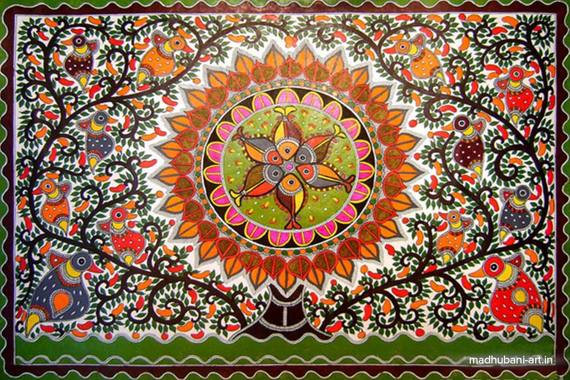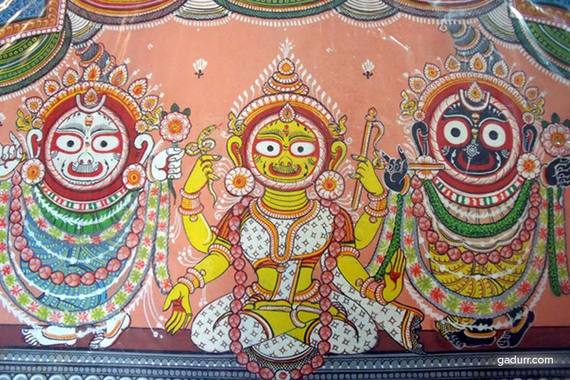India has long been celebrated for its art and culture, and many of the finest forms have flowered in villages and tribal settlements where they have long served as modes of creative expression and communication. One of the challenges we face today is keeping these art forms alive but with support from government organizations, patrons of art and artists' support groups there's been a revival in recent years. The growing popularity and commercialisation of these art forms has seen the uplift of many artisan communities and they are increasingly becoming integrated with the mainstream.
Four particularly exquisite folk art styles are Madhubani, Warli, Gond and Pattachitra. They have several things in common: all use natural dyes for painting and even the brushes are made from natural materials like bamboo and twigs. Completely hand-drawn and -painted, these works of art take time and effort, and therein lies their value. Anything handmade, with hundreds of years of tradition behind it, is truly priceless!
Madhubani paintings, Bihar
Image may be NSFW.
Clik here to view.
Madhubani or Mithila art originated in Bihar, and was once the sole province of women. The art form developed as a decoration for village homes but has now found its way on to framed canvases. Recurring themes include the Hindu pantheon, natural objects such as the sun and the moon, sacred plants like tulsi and banana stem and social scenes like weddings or royal court gatherings. Madhubani paintings also feature certain motifs that have specific meanings -- elephants convey good luck, fish stand for fertility, parrots symbolise love and so on.
Legend has it that King Janak of Mithila in Bihar commissioned artists to draw paintings at the time of his daughter Sita's wedding to Lord Rama. We find some vivid descriptions of the wall and floor paintings in Tulsidas's magnum opus, Ramcharitamanas. Madhubani also literally translates to "honey in forest".
Warli art, Maharashtra
Image may be NSFW.
Clik here to view.
The Warlis are a tribe from Maharashtra and their eponymous art form is distinguished by the liberal use of geometric forms such as triangles, circles and squares. Unlike Madhubani paintings, Warli art features white shapes and forms against a monochromatic background. Also practiced generally by the illiterate women folk, their words took the form of these graphical representations. Warli art represents the daily social activities of this community and vivid representations of village life, such as wedding processions and harvest celebrations, are common. Look out also for depictions of festivities featuring men and women gathered in circles around a tarpa player (a trumpet-like instrument). Since the Adivasis worship nature as divine many paintings are embellished with natural elements such as the sun, moon, rain and lightning.
Gond art, Madhya Pradesh
Image may be NSFW.
Clik here to view.
Dashes, dots and lines come together to describe the abundance of nature in the form of flora and fauna as well as deities such as Kali in the artwork of MP's Gond Adivasis. The use of lines is such that the vibrant, colourful paintings seem possessed of life. Today, Gond paintings feature on products such as wooden trays and boxes and have become extremely popular even abroad.
Pattachitra, Orissa
Image may be NSFW.
Clik here to view.
This is an extremely beautiful form of art practiced mostly in Puri district, Orissa. Pattachitra is generally created on cotton or silk cloth or as etched on palm leaves. Most of the artisans come from a village known as Raghurajpur and the art form can be traced back to the period in which Lord Jagannath Temple was established.
The process of making a Pattachitra work is painstaking. The canvas has to be prepared in advance -- first the base is prepared by coating the cloth with soft, white chalk powder and glue made from tamarind seeds. This gives strength to the canvas and it is now ready to absorb the paint. The frame or border is painted first and then - with no sketch to guide the artist - brush strokes bring alive the figures of deities such as Lord Jagannath and religious themes like the Krishna Leela. The chitrakaars finish the painting with black lines that give the effect of pen work. Finally the canvas is held over a charcoal fire and lacquer is applied to the surface. This makes the painting water-resistant and durable, besides giving it a shining finish.
This form of art is widely seen on wooden boxes and bowls, coconut shells and even on Tussar silk.
Incorporating these art forms in home décor
These ancient folk art traditions have found their way into modern homes, where they add pops of colour, whimsy and an ethnic aesthetic. Put them up on walls for maximum impact: we think Pattachitra art is especially suitable for puja rooms, while Madhubani paintings are a good choice for believers in Vastu, since the motifs are said to denote luck and prosperity. Warli adds a charming rural sensibility, while Gond art has an instant brightening effect. If you wish to incorporate elements from these art forms in a more understated way, consider using lamps, coasters, bed spreads, cushion covers, trays, frames etc that feature them.
Image may be NSFW.
Clik here to view.![2015-11-30-1448866095-1844971-1.jpg]()
Image may be NSFW.
Clik here to view.![2015-11-30-1448866119-6251924-2.jpg]()
Sustaining Indian folk art
It is important to sustain the art form and carry on the legacy. Preserving Indian art forms is a responsibility that we as citizens have to equally share with the government authorities and the artists. Most of this art is now taught in various art schools across India and have become a popular stylized art. In our small way we can always encourage the artisans by buying it directly from them through the various art & craft exhibitions that are held across the country periodically.
Written by Sangita Aanand
Four particularly exquisite folk art styles are Madhubani, Warli, Gond and Pattachitra. They have several things in common: all use natural dyes for painting and even the brushes are made from natural materials like bamboo and twigs. Completely hand-drawn and -painted, these works of art take time and effort, and therein lies their value. Anything handmade, with hundreds of years of tradition behind it, is truly priceless!
Madhubani paintings, Bihar
Image may be NSFW.
Clik here to view.

Madhubani or Mithila art originated in Bihar, and was once the sole province of women. The art form developed as a decoration for village homes but has now found its way on to framed canvases. Recurring themes include the Hindu pantheon, natural objects such as the sun and the moon, sacred plants like tulsi and banana stem and social scenes like weddings or royal court gatherings. Madhubani paintings also feature certain motifs that have specific meanings -- elephants convey good luck, fish stand for fertility, parrots symbolise love and so on.
Legend has it that King Janak of Mithila in Bihar commissioned artists to draw paintings at the time of his daughter Sita's wedding to Lord Rama. We find some vivid descriptions of the wall and floor paintings in Tulsidas's magnum opus, Ramcharitamanas. Madhubani also literally translates to "honey in forest".
Warli art, Maharashtra
Image may be NSFW.
Clik here to view.

The Warlis are a tribe from Maharashtra and their eponymous art form is distinguished by the liberal use of geometric forms such as triangles, circles and squares. Unlike Madhubani paintings, Warli art features white shapes and forms against a monochromatic background. Also practiced generally by the illiterate women folk, their words took the form of these graphical representations. Warli art represents the daily social activities of this community and vivid representations of village life, such as wedding processions and harvest celebrations, are common. Look out also for depictions of festivities featuring men and women gathered in circles around a tarpa player (a trumpet-like instrument). Since the Adivasis worship nature as divine many paintings are embellished with natural elements such as the sun, moon, rain and lightning.
Gond art, Madhya Pradesh
Image may be NSFW.
Clik here to view.

Dashes, dots and lines come together to describe the abundance of nature in the form of flora and fauna as well as deities such as Kali in the artwork of MP's Gond Adivasis. The use of lines is such that the vibrant, colourful paintings seem possessed of life. Today, Gond paintings feature on products such as wooden trays and boxes and have become extremely popular even abroad.
Pattachitra, Orissa
Image may be NSFW.
Clik here to view.

This is an extremely beautiful form of art practiced mostly in Puri district, Orissa. Pattachitra is generally created on cotton or silk cloth or as etched on palm leaves. Most of the artisans come from a village known as Raghurajpur and the art form can be traced back to the period in which Lord Jagannath Temple was established.
The process of making a Pattachitra work is painstaking. The canvas has to be prepared in advance -- first the base is prepared by coating the cloth with soft, white chalk powder and glue made from tamarind seeds. This gives strength to the canvas and it is now ready to absorb the paint. The frame or border is painted first and then - with no sketch to guide the artist - brush strokes bring alive the figures of deities such as Lord Jagannath and religious themes like the Krishna Leela. The chitrakaars finish the painting with black lines that give the effect of pen work. Finally the canvas is held over a charcoal fire and lacquer is applied to the surface. This makes the painting water-resistant and durable, besides giving it a shining finish.
This form of art is widely seen on wooden boxes and bowls, coconut shells and even on Tussar silk.
Incorporating these art forms in home décor
These ancient folk art traditions have found their way into modern homes, where they add pops of colour, whimsy and an ethnic aesthetic. Put them up on walls for maximum impact: we think Pattachitra art is especially suitable for puja rooms, while Madhubani paintings are a good choice for believers in Vastu, since the motifs are said to denote luck and prosperity. Warli adds a charming rural sensibility, while Gond art has an instant brightening effect. If you wish to incorporate elements from these art forms in a more understated way, consider using lamps, coasters, bed spreads, cushion covers, trays, frames etc that feature them.
Image may be NSFW.
Clik here to view.

Image may be NSFW.
Clik here to view.

Sustaining Indian folk art
It is important to sustain the art form and carry on the legacy. Preserving Indian art forms is a responsibility that we as citizens have to equally share with the government authorities and the artists. Most of this art is now taught in various art schools across India and have become a popular stylized art. In our small way we can always encourage the artisans by buying it directly from them through the various art & craft exhibitions that are held across the country periodically.
Written by Sangita Aanand